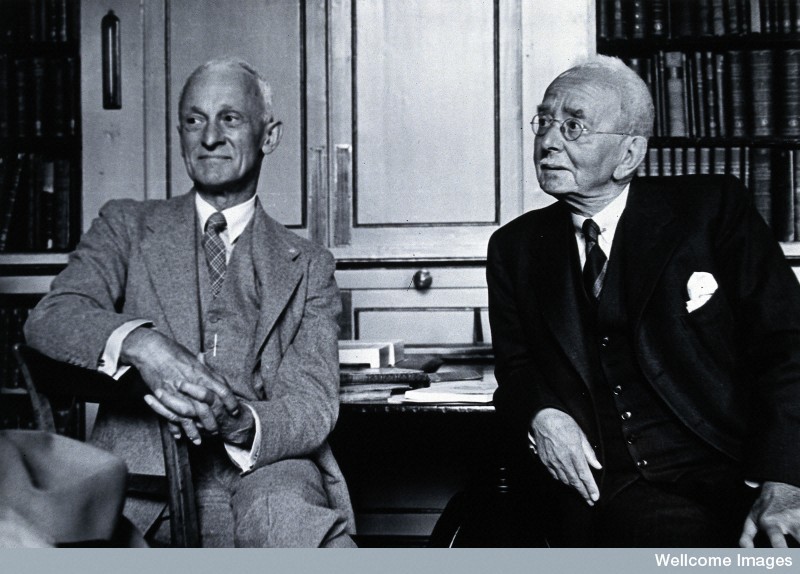Cushing Center, Yale Medical Library
Introduction
Text-to-speech Audio
Yale's fascinating "brain room" showcases the collection of Harvey Cushing, the "father of neurosurgery." Over the course of his career, he compiled what is now known as the Cushing Brain Tumor registry: 2200+ medical case studies consisting of notes, microscopic slides, tumor specimens, photo negatives, and even entire brains. These materials span several decades, from the late 19th century up to the 1930s, documenting a time of considerable change and advancement in neurological medicine. Today, these brain specimens and other materials reside in the Cushing/Whitney Medical Library.
An active Yale Proximity ID Card is required to visit on your own. Visitors without one should register at the Medical Library’s Circulation Desk to receive a Cushing Center Proxy Card. Before traveling to visit the Center, you may want to call ahead to confirm its availability.
Images
Inside the Cushing Center (Yale News)

Harvey Cushing, on the left, in 1938. (Wellcome Library, London)

Backstory and Context
Text-to-speech Audio
After graduating from Yale in 1891, Cushing earned his medical degree from Harvard Medical School and then trained as a surgeon at Johns Hopkins Hospital. He soon developed a particular fascination with neurosurgery. In 1913, Cushing returned to Harvard as surgeon-in-chief, operating each year on hundreds of patients about whom he kept meticulous records. He came to Yale as the Sterling Professor of Medicine in Neurology in 1933.
Cushing gained a reputation for dramatically raising his patients' survival rates, due in large part to his sterile operating procedures, which lessened the risk of infection. While other neurosurgeons of his day had surgery mortality rates between 38 and 50%, Cushing's hovered around 8%.
He also promoted safer methods of anesthetization. Today, it seems only natural to monitor the vital signs of a patient under anesthetic, but in Cushing's time, it was groundbreaking. By recording the patient's pulse, respiration, and temperature in his "ether charts," he made surgical anesthetization a more precise, controlled procedure. Cushing also supported the use of local anesthesia when possible, rather than run the higher risks of general anesthesia. His insistence on safer anesthesia was rooted in personal observation and experience. He was well-aware early in his medical training that "etherized" patients sometimes did not wake up. In a letter from 1920, Cushing discussed an experience administering ether during his second year of medical school. The elderly patient died. In Cushing's words:
I supposed that I had killed the patient. The operation was completed in spite of the episode, as a demonstration to the class. I slunk out of the hospital, walked the streets of North Boston the rest of the afternoon, and in the evening went to the surgeon’s house to ask if there was any possible way I could atone for the calamity to the man’s family before I left the Medical School and went into some other business.
Cushing gained a reputation for dramatically raising his patients' survival rates, due in large part to his sterile operating procedures, which lessened the risk of infection. While other neurosurgeons of his day had surgery mortality rates between 38 and 50%, Cushing's hovered around 8%.
He also promoted safer methods of anesthetization. Today, it seems only natural to monitor the vital signs of a patient under anesthetic, but in Cushing's time, it was groundbreaking. By recording the patient's pulse, respiration, and temperature in his "ether charts," he made surgical anesthetization a more precise, controlled procedure. Cushing also supported the use of local anesthesia when possible, rather than run the higher risks of general anesthesia. His insistence on safer anesthesia was rooted in personal observation and experience. He was well-aware early in his medical training that "etherized" patients sometimes did not wake up. In a letter from 1920, Cushing discussed an experience administering ether during his second year of medical school. The elderly patient died. In Cushing's words:
I supposed that I had killed the patient. The operation was completed in spite of the episode, as a demonstration to the class. I slunk out of the hospital, walked the streets of North Boston the rest of the afternoon, and in the evening went to the surgeon’s house to ask if there was any possible way I could atone for the calamity to the man’s family before I left the Medical School and went into some other business.
To my perfect amazement I was told it was nothing at all, that I had nothing to do with the
man’s death, that he had a strangulated hernia, and had been vomiting all night anyway, and that sort of thing happened frequently and I had better forget about it and go on with the Medical School. I went on with the Medical School but have never forgotten about it.
(quoted in Hirsch and Smith).
(quoted in Hirsch and Smith).
Sources
Dodson, Helen. "Brain collection commemorates physician’s contributions, kindness." Yale News, September 16, 2010. http://news.yale.edu/2010/09/16/brain-collection-commemorates-physician-s-contributions-kindness.
"Harvey Cushing and the Cushing Center." Yale University. Accessed May 22, 2017. http://library.medicine.yale.edu/cc/history.
Hirsch, Nicholas, and Gary Smith. "Harvey Cushing: His Contribution to Anesthesia." Anesthesia & Analgesia 65, (1986): 288-293.
"A Neurosurgeon’s Photographic Legacy." Yale Medicine 42 (Spring 2008). Accessed May 26, 2017. http://ymm.yale.edu/spring2008/features/feature/51545/.
"Harvey Cushing and the Cushing Center." Yale University. Accessed May 22, 2017. http://library.medicine.yale.edu/cc/history.
Hirsch, Nicholas, and Gary Smith. "Harvey Cushing: His Contribution to Anesthesia." Anesthesia & Analgesia 65, (1986): 288-293.
"A Neurosurgeon’s Photographic Legacy." Yale Medicine 42 (Spring 2008). Accessed May 26, 2017. http://ymm.yale.edu/spring2008/features/feature/51545/.
